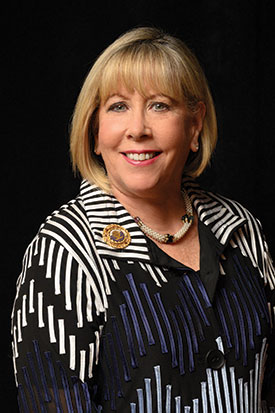Hadassah
President's Column
A Crooked But Clear Line

Hadassah National President
Just as we don’t feel the rotation of the Earth, we may not be aware of sea changes in the flow of history. But if you belong to Hadassah you are part the changing tide.
We might find some insight in the mission of Hadassah medical professionals who had the opportunity to do the work they routinely perform in Jerusalem as part of HMO’s volunteer force at the Przemyśl Refugee Center on the Polish-Ukrainian border.
Janna Raikhelgauz, a Kyiv-born nurse who works in Hadassah Ein Kerem’s Pediatric Hemato-Oncology Department, wondered if she would be lonely spending her birthday at the refugee center, far from family and friends in Israel. “I quickly discovered it was the opposite,” she told a reporter from the Israeli newspaper Maariv. “We treated a young girl who had an abortion who looked just like one of my classmates. When I measured the blood pressure of one patient, I noticed she had my grandmother’s hands. When another patient, who regained consciousness after an attack of epilepsy, looked at me for a moment, I saw his eyes were the same color as those of my history teacher.… No, I didn’t feel alone.”
The volunteers see hundreds of patients on a typical day, few of whom have life-threatening conditions. One exception was Natasha, who had survived the massive bombing of Kherson and then a month-long journey with her three children to the Polish border. When she arrived she was also 41-weeks pregnant. “Natasha knew something was wrong,” said Dr. Doron Kabri, head of Ein Kerem’s High-Risk Pregnancy Clinic. “She was very happy to hear that I was a specialist in obstetric and gynecologic medicine.” After a series of tests, Dr. Kabri and his team determined that she was suffering from advanced pre-eclampsia, a dangerous condition for mother and baby. They arranged for her quick evacuation to a Polish hospital, where she gave birth to a healthy infant. The diagnosis saved her pregnancy.
But there’s another piece to the Ukrainian crisis. Hadassah is not only sending personnel to the Polish border, it is also bringing young refugees to Israel. The first 50 Ukrainian teens arrived at our two youth villages, Hadassah Neurim and Meir Shfeyah, in March and April. Among them were seven elite athletes who, at the time of the Russian invasion, were in training for an international competition in Greece; their training continued in Israel.
Our medical outreach and reception of youngsters at our youth villages are part of a much larger movement of six million Ukrainian refugees and also a much deeper core Israeli value. In the first two months after the Russian invasion, some 15,000 Jewish immigrants from Ukraine, Belarus and Russia arrived in Israel—three times the number for all of last year. Usually outreach to other countries and bringing Jewish immigrants are separate missions, but this year they have come together.
What has happened since February follows a crooked but clear line that started in June 1967, when Israel’s victory in the Six-Day War galvanized Jews in the Soviet Union, igniting years of defiant protest that contributed to the collapse of communism, through the massive emigration that both preceded and followed the Soviet breakup, and up to the violent attempt to put part of the old empire back together in 2022.
During this period of 55 years—less than a normal lifetime—Israel’s population has surged from 2.7 million to 9.6 million.
As it has flourished, Israel has continuously reached out to help other nations in need, from newly independent countries in the 1960s to lands devastated by natural and manmade disasters. At the same time, it has provided a home to Jews who cannot imagine living anywhere else and—just as important—those who have nowhere else to go.
Hadassah plays a key role in the Jewish and human revolution. And unlike the imperceptible revolution of our planet, there are things that we can do to help affect change every day.









 Facebook
Facebook Instagram
Instagram Twitter
Twitter
Leave a Reply